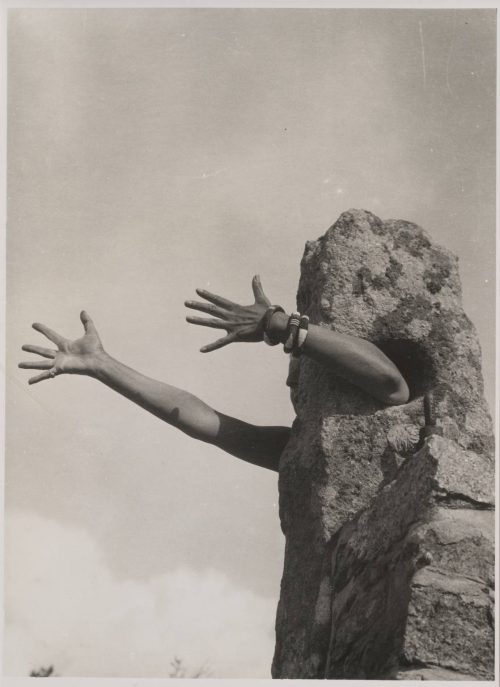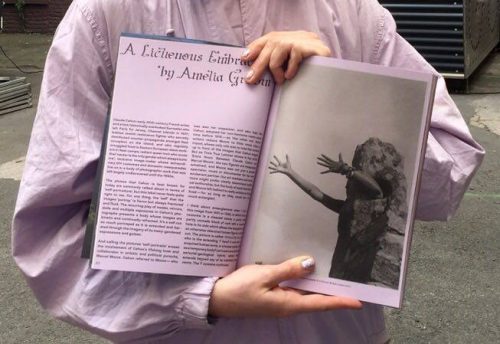Claude Cahun: early 20th-century French writer and artist; historically overlooked Surrealist who left Paris for Jersey, Channel Islands in 1937; lesbian Jewish resistance fighter who secretly distributed counter-propaganda amongst Nazi occupiers on the island, and who regularly smuggled food to Eastern European slave workers in Nazi camps; radiant queer icon who wrote that ‘neuter is the only gender which always suits me’; reclusive image-maker whose extraordinary DIY costumes and domestic masquerades live on in a body of photographic work that was left largely undiscovered until the 1990s.
The photos that Cahun is best known for today are commonly talked about in terms of ‘self-portraiture’, but this label never feels quite right to me. For one thing, the ‘self’ that the images ‘portray’ is fierce but always fractured and fluid. The recurring play of masks, mirrors, dolls and multiple exposures in Cahun’s photographs presents a body whose images are kinetic and continually refracted. It’s a self not so much portrayed as it is extended and iterated, through the imagery of its many-gendered expressions and guises.
And, calling the pictures ‘self-portraits’ erases the involvement of Cahun’s lifelong lover and collaborator in artistic and political pursuits, Marcel Moore. Cahun referred to Moore – who was also her stepsister, and who had, like Cahun, adopted her non-feminine name some time before 1919 – as ‘the other me’. Some writers reduce Moore to little more than a tripod, whose only role was to hold the camera up in front of the images that Cahun staged. But as Tirza True Latimer shows in her article ‘Entre Nous: Between Claude Cahun and Marcel Moore’, the two figures are inseparably entwined, and Moore was not just a passive spectator, muse or documenter for her more exuberant partner. Our art markets and institutions might prefer clearly determined autonomous authorship, but the body of work that Cahun and Moore left behind is really evidence of lives lived – for as long as they could be – very much entangled.
I think about entanglement when I look at this image from 1931 or 1932, in which Cahun’s costume is a sleeved stone; a partly made, partly unmade block of rock with a receptive hole in its side which allows the bangled arm of an otherwise obscured human figure to extend out. The picture is called ‘I Extend my Arms’, but who is the extending ‘I’ here? A rock who has acquired human arms, or a human taking a rock as a temporary body? Let’s see it as a biological-sartorial-geological hybrid, whose image extends beyond any of its individual components.
The ‘I’ contains multitudes. Look at the rock which is being worn as a body: it is also already wearing bodies of lichens all over its surface. And lichens are themselves zones of hybrid bodies: they’re composite creatures who extend across surfaces while growing, with an almost lithic slowness, from a relationship between fungi (which are neither plant nor animal, and so form a separate classificatory kingdom of their own) and cyanobacteria or algae.
As true collaborations, lichens have properties that differ from those of any of their component creatures. Because of this, they are well-known troublemakers within the taxonomic systems of natural science, where individual members of a given species are supposed to share an evolutionary lineage. While there are thousands of kinds of lichens, all of them are meeting points of entirely different kinds of life, with entirely different ancestries. So the very existence of lichens destabilizes boundaries between organisms, species and kingdoms.
And, the thing is, lichens are not just curious anomalies; they can also be understood as illustrative of the fact that all life is determined by complex ‘multispecies entanglements’. In the work of the late biologist Lynn Margulis, symbiosis (literally ‘living together’) is not approached as a marginal sub-field, but rather as the driving force of all biological novelty and complexity. Her concept of ‘symbiogenesis’ acknowledges evolution’s many layers of cooperation, interdependence and shared responsibility. Principles of ‘becoming with the other’ seriously complicate the classical Darwinian notions of competitive ‘survival of the fittest’ here, as life is rethought as something essentially collaborative and composite.
In Margulis’s 1995 book What Is Life? (coauthored with her son Dorian Sagan), cross-kingdom alliances between algae and fungi are shown to have been crucial not just for the existence of symbiotic organisms like lichens but also for the development of vegetative life in general. Plants could not have evolved from algae in the oceans and taken root on dry land without the collaborative efforts of fungi, who have persistently worked underground to bring nutrients to their upright photosynthesizing cohabiters. And, Margulis and Sagan write, fungi remain vitally intertwined in the roots of more than 95 percent of plant species today. More than just clusters of individual organisms, forests are networks of alliances.
During the 1960s, when Margulis first proposed that symbiosis was a key driver of cellular evolution, she was generally ignored – or outright ridiculed – within the male-dominated scientific community. But she persevered, right up until her death in 2011, and today symbiosis is increasingly understood as a basic principle of life. In a 2012 article for The Quarterly Review of Biology, scientists Scott Gilbert, Jan Sapp and Alfred Tauber set out to demonstrate that in contemporary biology, none of the criteria which have conventionally been used to define organisms as individuals are tenable. On the anatomical, embryological, physiological, immunological, genetic and evolutionarily levels, they show, we have never been individuals. The article is dedicated to the memory of Lynn Margulis, and it concludes with the rallying call ‘we are all lichens’.
Like lichens, our bodies exist as sets of relations. The trillions of microorganisms who inhabit and make up our flesh outnumber the human cells by ten to one. Whether these non-human companions are helpful or harmful or just hitching a ride, they are very real reminders that there is no such thing as an untainted body – we’re born dirty and full of others. And this is true not just in biological terms. Looking at the pictures that Cahun and Moore made together, we can find the boundaries of bodies being continually renegotiated, as flesh is infected by circulating imagery, and selves are extended out through an erotics of prosthetics. This is entangled life: porous, impure, magnetic.
This text appears in the FUTURE issue of Girls Like Us magazine, published September 2017. ‘I Extend My Arms’ is in the TATE collection. The image below comes from GLU’s Instagram. They also made these great ‘I Extend My Arms’ T-shirts!

